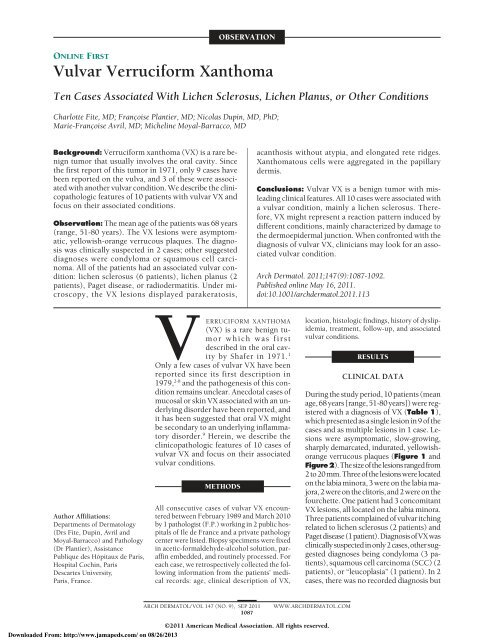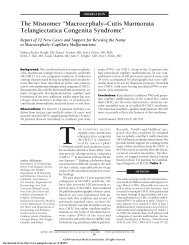Vulvar Verruciform Xanthoma - JAMA Pediatrics
Vulvar Verruciform Xanthoma - JAMA Pediatrics
Vulvar Verruciform Xanthoma - JAMA Pediatrics
Create successful ePaper yourself
Turn your PDF publications into a flip-book with our unique Google optimized e-Paper software.
ONLINE FIRSTOBSERVATION<strong>Vulvar</strong> <strong>Verruciform</strong> <strong>Xanthoma</strong>Ten Cases Associated With Lichen Sclerosus, Lichen Planus, or Other ConditionsCharlotte Fite, MD; Françoise Plantier, MD; Nicolas Dupin, MD, PhD;Marie-Françoise Avril, MD; Micheline Moyal-Barracco, MDBackground: <strong>Verruciform</strong> xanthoma (VX) is a rare benigntumor that usually involves the oral cavity. Sincethe first report of this tumor in 1971, only 9 cases havebeen reported on the vulva, and 3 of these were associatedwith another vulvar condition. We describe the clinicopathologicfeatures of 10 patients with vulvar VX andfocus on their associated conditions.Observation: The mean age of the patients was 68 years(range, 51-80 years). The VX lesions were asymptomatic,yellowish-orange verrucous plaques. The diagnosiswas clinically suspected in 2 cases; other suggesteddiagnoses were condyloma or squamous cell carcinoma.All of the patients had an associated vulvar condition:lichen sclerosus (6 patients), lichen planus (2patients), Paget disease, or radiodermatitis. Under microscopy,the VX lesions displayed parakeratosis,acanthosis without atypia, and elongated rete ridges.<strong>Xanthoma</strong>tous cells were aggregated in the papillarydermis.Conclusions: <strong>Vulvar</strong> VX is a benign tumor with misleadingclinical features. All 10 cases were associated witha vulvar condition, mainly a lichen sclerosus. Therefore,VX might represent a reaction pattern induced bydifferent conditions, mainly characterized by damage tothe dermoepidermal junction. When confronted with thediagnosis of vulvar VX, clinicians may look for an associatedvulvar condition.Arch Dermatol. 2011;147(9):1087-1092.Published online May 16, 2011.doi:10.1001/archdermatol.2011.113Author Affiliations:Departments of Dermatology(Drs Fite, Dupin, Avril andMoyal-Barracco) and Pathology(Dr Plantier), AssistancePublique des Hôpitaux de Paris,Hospital Cochin, ParisDescartes University,Paris, France.VERRUCIFORM XANTHOMA(VX) is a rare benign tumorwhich was firstdescribed in the oral cavityby Shafer in 1971. 1Only a few cases of vulvar VX have beenreported since its first description in1979, 2-8 and the pathogenesis of this conditionremains unclear. Anecdotal cases ofmucosal or skin VX associated with an underlyingdisorder have been reported, andit has been suggested that oral VX mightbe secondary to an underlying inflammatorydisorder. 9 Herein, we describe theclinicopathologic features of 10 cases ofvulvar VX and focus on their associatedvulvar conditions.METHODSAll consecutive cases of vulvar VX encounteredbetween February 1989 and March 2010by 1 pathologist (F.P.) working in 2 public hospitalsof Ile de France and a private pathologycenter were listed. Biopsy specimens were fixedin acetic-formaldehyde-alcohol solution, paraffinembedded, and routinely processed. Foreach case, we retrospectively collected the followinginformation from the patients’ medicalrecords: age, clinical description of VX,location, histologic findings, history of dyslipidemia,treatment, follow-up, and associatedvulvar conditions.RESULTSCLINICAL DATADuring the study period, 10 patients (meanage, 68 years [range, 51-80 years]) were registeredwith a diagnosis of VX (Table 1),which presented as a single lesion in 9 of thecases and as multiple lesions in 1 case. Lesionswere asymptomatic, slow-growing,sharply demarcated, indurated, yellowishorangeverrucous plaques (Figure 1 andFigure2).Thesizeofthelesionsrangedfrom2to20mm.Threeofthelesionswerelocatedon the labia minora, 3 were on the labia majora,2wereontheclitoris,and2wereonthefourchette. One patient had 3 concomitantVX lesions, all located on the labia minora.Three patients complained of vulvar itchingrelated to lichen sclerosus (2 patients) andPagetdisease(1patient).DiagnosisofVXwasclinicallysuspectedinonly2cases,othersuggesteddiagnoses being condyloma (3 patients),squamous cell carcinoma (SCC) (2patients), or “leucoplasia” (1 patient). In 2cases, there was no recorded diagnosis butARCH DERMATOL/ VOL 147 (NO. 9), SEP 20111087WWW.ARCHDERMATOL.COM©2011 American Medical Association. All rights reserved.Downloaded From: http://www.jamapeds.com/ on 08/26/2013
the final diagnosis was VX. Excision was incomplete, andthe patient experienced recurrence 4 months later but refusedany further surgery. Six years later, the lesion hadgrown, and histologic examination of partial penectomyrevealed an SCC with many clusters of xanthomatous cells.Second, we did not search for human papillomavirus (HPV)in our cases. Owing to the clinical condyloma-like appearanceof VX and its location in the mucosa, a role of HPV inthe pathogenesis of VX has been suggested. However, atleast 12 studies using techniques such as electron microscopicexamination, Southern blotting, immunohistochemicalanalysis, polymerase chain reaction (PCR), nestedPCR followed by sequencing, or in situ hybridization havefailed to identify HPV in a total of 22 cases. 4,7,8,36-44 To ourknowledge, only 3 studies identified HPV DNA in 1 of 12cases of oral VX (HPV-6 and HPV-11), 45 1 case of scrotalVX (HPV-6), 46 and 3 cases of cutaneous VX (HPV-16, HPV-23, and HPV-36). 47 The low rate of HPV positivity publishedand the absence of specific pathologic features of HPVin our 10 cases lead us to consider HPV as being incidentalrather than etiologic in cases of vulvar VX. Third, wedid not explore the lipid metabolism of our patients. Thepresence of lipid-laden cells within the lesions of VX hasled some investigators to suggest that VX is associated witha systemic lipid abnormality. 37 However, most of the reportedVX patients are normolipemic. 5,6,9,16,22,34,48-50 Four ofour patients reported hyperlipidemia, but the age of thesepatients (Table 1) suggests that these lipid abnormalitiesshould be considered as an incidental finding. In addition,cutaneous lipid deposition related to hyperlipidemiais usually associated with xanthomas, which are clinicallyand histologically different from VX (no acanthosis, presenceof Touton giant cells located deeper in the dermis).Lipid-laden macrophages of VX could result from a locallipid clearance disorder of the degenerating epidermis. Thiscould be related to a mutation of the 3-hydroxysteroiddehydrogenase (NSDHL) gene, which is involved in cholesterolbiosynthesis, as suggested by Mehra et al. 51In conclusion, vulvar VX is a rare and misleading yellowish-orangeverrucous tumor that can simulate a genitalwart, a verrucous carcinoma, or an SCC. Our 10 casesof vulvar VX were all associated with another vulvar condition,mainly lichen sclerosus or lichen planus. Both cliniciansand pathologists should be aware of this associationand search for a lichen, either active or quiescent, inthe tissues surrounding the VX. Because we cannot strictlyexclude the possibility of transformation of vulvar VX intoan SCC, we recommend complete surgical removal of thistumor, all the more so if it arises on a lichen sclerosus orplanus, which are both potential precursors of SCC.Accepted for Publication: March 16, 2011.Published Online: May 16, 2011. doi:10.1001/archdermatol.2011.113Correspondence: Charlotte Fite, MD, 25 rue Basfroi,75011 Paris, France (charlotte.fite@noos.fr).Author Contributions: All authors had full access to allof the data in the study and take responsibility for theintegrity of the data and the accuracy of the data analysis.Study concept and design: Fite, Plantier, and Moyal-Barracco. Acquisition of data: Fite, Plantier, and Moyal-Barracco. Analysis and interpretation of data: Plantier,Dupin, Avril, and Moyal-Barracco. Drafting of the manuscript:Fite, Plantier, and Moyal-Barracco. Critical revisionof the manuscript for important intellectual content:Plantier, Dupin, Avril, and Moyal-Barracco. Statisticalanalysis: Fite. Administrative, technical, and material support:Dupin. Study supervision: Plantier, Dupin, Avril, andMoyal-Barracco.Financial Disclosure: None reported.Additional Contributions: We are indebted toMonique Pelisse, MD, Sophie Berville, MD, and JeanneWendling, MD.REFERENCES1. Shafer WG. <strong>Verruciform</strong> xanthoma. Oral Surg Oral Med Oral Pathol. 1971;31(6):784-789.2. Santa Cruz DJ, Martin SA. <strong>Verruciform</strong> xanthoma of the vulva: report of two cases.Am J Clin Pathol. 1979;71(2):224-228.3. de Rosa G, Barra E, Gentile R, Boscaino A, Di Prisco B, Ayala F. <strong>Verruciform</strong> xanthomaof the vulva: case report. Genitourin Med. 1989;65(4):252-254.4. Orchard GE, Wilson Jones E, Russell Jones R. <strong>Verruciform</strong> xanthoma: an immunocytochemicalstudy. Br J Biomed Sci. 1994;51(1):28-34.5. Kishimoto S, Takenaka H, Shibagaki R, Nagata M, Yasuno H. <strong>Verruciform</strong> xanthomain association with a vulval fibroepithelial polyp. Br J Dermatol. 1997;137(5):816-820.6. Leong FJ, Meredith DJ. <strong>Verruciform</strong> xanthoma of the vulva: a case report. PatholRes Pract. 1998;194(9):661-667.7. Reich O, Regauer S. Recurrent verruciform xanthoma of the vulva. Int J GynecolPathol. 2004;23(1):75-77.8. Sopena J, Gamo R, Iglesias L, Rodriguez-Peralto JL. Disseminated verruciformxanthoma. Br J Dermatol. 2004;151(3):717-719.9. Zegarelli DJ, Aegarelli-Schmidt EC, Zegarelli EV. <strong>Verruciform</strong> xanthoma: a clinical,light microscopic, and electron microscopic study of two cases. Oral SurgOral Med Oral Pathol. 1974;38(5):725-734.10. Oliveira PT, Jaeger RG, Cabral LA, Carvalho YR, Costa AL, Jaeger MM. <strong>Verruciform</strong>xanthoma of the oral mucosa: report of four cases and a review of theliterature. Oral Oncol. 2001;37(3):326-331.11. Philipsen HP, Reichart PA, Takata T, Ogawa I. <strong>Verruciform</strong> xanthoma: biologicalprofile of 282 oral lesions based on a literature survey with nine new cases fromJapan. Oral Oncol. 2003;39(4):325-336.12. Neville BW, Coleman PJ, Richardson MS. <strong>Verruciform</strong> xanthoma associated withan intraoral warty dyskeratoma. Oral Surg Oral Med Oral Pathol Oral Radiol Endod.1996;81(1):3-4.13. Poulopoulos AK, Epivatianos A, Zaraboukas T, Antoniades D. <strong>Verruciform</strong> xanthomacoexisting with oral discoid lupus erythematosus. Br J Oral Maxillofac Surg.2007;45(2):159-160.14. Ide F, Obara K, Yamada H, Mishima K, Saito I, Kusama K. Cellular basis of verruciformxanthoma: immunohistochemical and ultrastructural characterization.Oral Dis. 2008;14(2):150-157.15. Yu CH, Tsai TC, Wang JT, et al. Oral verruciform xanthoma: a clinicopathologicstudy of 15 cases. J Formos Med Assoc. 2007;106(2):141-147.16. Neville BW, Weathers DR. <strong>Verruciform</strong> xanthoma. Oral Surg Oral Med Oral Pathol.1980;49(5):429-434.17. Polonowita AD, Firth NA, Rich AM. <strong>Verruciform</strong> xanthoma and concomitant lichenplanus of the oral mucosa: a report of three cases. Int J Oral MaxillofacSurg. 1999;28(1):62-66.18. Miyamoto Y, Nagayama M, Hayashi Y. <strong>Verruciform</strong> xanthoma occurring withinoral lichen planus. J Oral Pathol Med. 1996;25(4):188-191.19. Anbinder AL, de Souza Quirino MR, Brandão AA. <strong>Verruciform</strong> xanthoma and neurofibromatosis:a case report [published online July 15, 2010]. Br J Oral MaxillofacSurg. 2010.20. Herrera-Goepfert R, Lizano-Soberón M, García-Perales M. <strong>Verruciform</strong> xanthomaof the esophagus. Hum Pathol. 2003;34(8):814-815.21. Kraemer BB, Schmidt WA, Foucar E, Rosen T. <strong>Verruciform</strong> xanthoma of the penis.Arch Dermatol. 1981;117(8):516-518.22. George WM, Azadeh B. <strong>Verruciform</strong> xanthoma of the penis. Cutis. 1989;44(2):167-170.23. Geiss DF, Del Rosso JQ, Murphy J. <strong>Verruciform</strong> xanthoma of the glans penis: abenign clinical simulant of genital malignancy. Cutis. 1993;51(5):369-372.24. Takiwaki H, Yokota M, Ahsan K, Yokota K, Kurokawa Y, Ogawa I. Squamous cellcarcinoma associated with verruciform xanthoma of the penis. Am J Dermatopathol.1996;18(5):551-554.ARCH DERMATOL/ VOL 147 (NO. 9), SEP 20111091WWW.ARCHDERMATOL.COM©2011 American Medical Association. All rights reserved.Downloaded From: http://www.jamapeds.com/ on 08/26/2013




